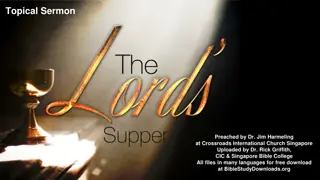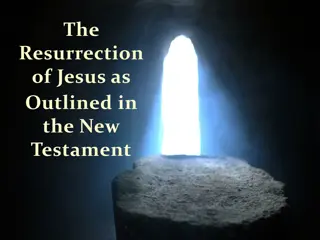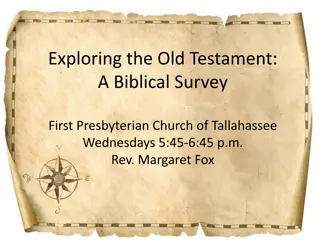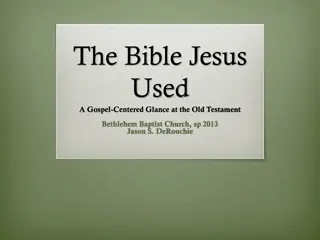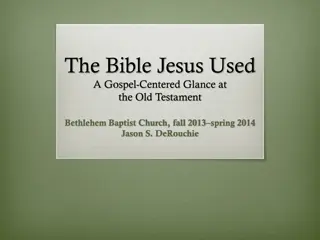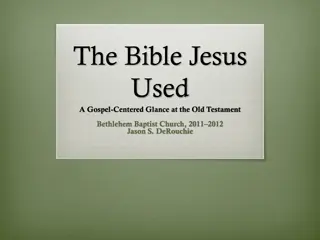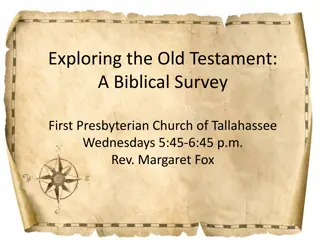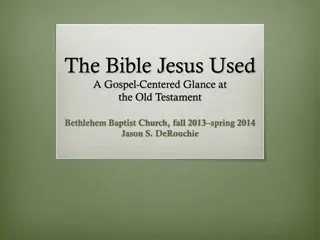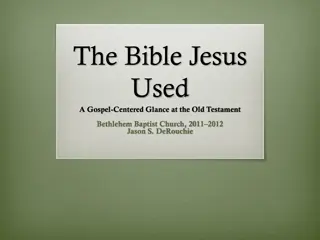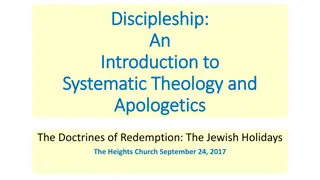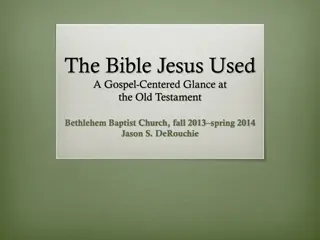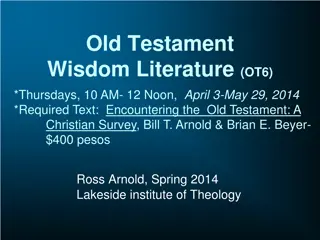Insights on Old Testament Narratives
Delve into the biblical narratives of the Old Testament, exploring the rise and fall of kingdoms, the covenantal nature of relationships with God, and the enduring hope found in divine promises. Discover the impactful lessons and themes woven throughout these historical accounts.
Download Presentation

Please find below an Image/Link to download the presentation.
The content on the website is provided AS IS for your information and personal use only. It may not be sold, licensed, or shared on other websites without obtaining consent from the author.If you encounter any issues during the download, it is possible that the publisher has removed the file from their server.
You are allowed to download the files provided on this website for personal or commercial use, subject to the condition that they are used lawfully. All files are the property of their respective owners.
The content on the website is provided AS IS for your information and personal use only. It may not be sold, licensed, or shared on other websites without obtaining consent from the author.
E N D
Presentation Transcript
The Bible Jesus Used A Gospel-Centered Glance at the Old Testament Bethlehem Baptist Church, sp 2013 Jason S. DeRouchie
12 Kings at a Glance Solomon s Rise, Reign, & Disobedience (970 930 B.C.) The Division of the Kingdom (930 B.C.) The Demise of the Kingdoms & Fall of Israel (930 723 B.C.) The Demise of Judah & Its Fall (723 586 B.C.) Postscript: Kingdom Hope 1 Kgs 1 11 1 Kgs 12 14 1 Kgs 15 2 Kgs 17 2 Kgs 18:1 25:21 2 Kgs 25:22 30
Synthesis of the Books Impact Because the book never lowers the call to human obedience and yet stresses both the disobedience of mankind and the conditional nature of the covenant, hope is placed in God s enablement, provision, and character. The exiles would have recognized the absolute failure of the Davidic line and would have been pushed to full reliance on the commitment of God to his own fame and on the sin-overcoming mercy of God toward his elect.
For those experiencing loss of king and country, the book would have also heightened hope in God s eternal kingdom and a future king who would satisfy all God s demands, ruling justly and establishing global peace.
The Makeup of the Southern & Northern Kingdoms Southern Kingdom- JUDAH 1(2) Tribes 1 dynasty/20 kings Jerusalem Jerusalem Struggling 586 B.C. by Babylon Northern Kingdom- ISRAEL 10 tribes 10 dynasties/20 kings Samaria Bethel & Dan Wealthy 723 B.C. by Assyria Size Dynasties & Kings Capitals Worship Centers Economic Status Destruction
The Demise of the Kingdom & Fall of Israel Key Question: Has the king been loyal to the Mosaic covenant? Two areas of focus: The attitude toward the central sanctuary in Jerusalem The approach to idolatry, especially as seen in Canaanite Baal worship
1 Kgs 16:3132. And as if it had been a light thing for him to walk in the sins of Jeroboam the son of Nebat, [Ahab] took for his wife Jezebel the daughter of Ethbaal king of the Sidonians, and went and served Baal and worshiped him. 32He erected an altar for Baal in the house of Baal, which he built in Samaria. 2 Kgs 10:28 29, 31. Thus Jehu wiped out Baal from Israel. 29But Jehu did not turn aside from the sins of Jeroboam the son of Nebat, which he made Israel to sin that is, the golden calves that were in Bethel and in Dan. . . . 31But Jehu was not careful to walk in the law of Yahweh, the God of Israel, with all his heart. He did not turn from the sins of Jeroboam, which he made Israel to sin.
2 Kgs 17:1617. And they abandoned all the commandments of Yahweh their God, and made for themselves metal images of two calves; and they made an Asherah and worshiped all the host of heaven and served Baal. 17And they burned their sons and their daughters as offerings and used divination and omens and sold themselves to do evil in the sight of Yahweh, provoking him to anger.
Key Features: The Annalistic Pattern Formulaic, chronological, parallel recording Theological in orientation Judean Kings Israelite Kings 17/17 15/17 17/17 -- -- 14/17 Year of ascent Name of father Length of reign in capital city 19/19 Age at beginning Name of mother Summary evaluation 11/19 9/19 (18/19) 17/19 17/19 19/19
Summary evaluation: Judah: Did they do what is evil (1 Kgs 14:21), walk in the ways of God and David (15:3), or do what is good (15:11). Israel: He did what was evil in the sight of Yahweh and walked in the sins of Jeroboam, son of Nebat (15:26, 34).
Selectivity: Emphasis on Covenant (Dis)Loyalty Jeroboam I vs. Jeroboam I and Ahab Jeroboam II: 41 year reign (793 753); golden age of Israel; just 7 verses (2 Kgs 14:23 29) Jeroboam I (931 910) and Ahab (874 853): each 22 years; 10 chapters (1 Kgs 10:26 14:20; 16:29 22:40) Why? Jeroboam I and Ahab were exceedingly wicked!
Hezekiah and Josiah Together 5 chapters (2 Kgs 18 20; 22 23); only two with unqualified praised (2 Kgs 18:5 6; 23:25). 2 Kgs 18:5 6. [Hezekiah] trusted in Yahweh, the God of Israel, so that there was none like him among all the kings of Judah after him, nor among those who were before him. 6For he held fast to Yahweh. He did not depart from following him, but kept the commandments that Yahweh commanded Moses. 2 Kgs 23:25. Before him there was no king like him, who turned to Yahweh with all his heart and with all his soul and with all his might, according to all the Law of Moses, nor did any like him arise after him.


